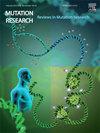The mechanism underlying the oncogenic potential of AAA+ ATPase PSMC4 in cancer is revealed by mutations and copy number amplifications
IF 1.5
4区 医学
Q4 BIOTECHNOLOGY & APPLIED MICROBIOLOGY
Mutation Research-Fundamental and Molecular Mechanisms of Mutagenesis
Pub Date : 2025-01-01
DOI:10.1016/j.mrfmmm.2025.111901
引用次数: 0
Abstract
Recent research has discovered a connection between the AAA+ ATPase PSMC4 (Proteasome 26S Subunit, ATPase 4) and several forms of cancer. However, a detailed analysis of the oncogenic potential of PSMC4 was elusive. In this study, we anticipate PSMC4's potential as a cancer biomarker. We aimed to comprehensively assess the expression profiles, prognostic significance, and relevant cellular pathways associated with it. Through our examination of various types of cancers, PSMC4 is found to be overexpressed. Interestingly, our result finds a positive correlation between PSMC4 overexpression and unfavourable overall survival rates in cancer. Further, we looked into the mutations and copy number amplifications of PSMC4 across various cancers. Our study reveals that missense mutations plays a great role behind the oncogenic potential of PSMC4. Several possible mutation sites are predicted. Interestingly, we found fifteen hotspot mutations in the ATPase domain of PSMC4. Additionally, PSMC4 has shown a high amplification percentage in various cancers. We are additionally attentive to the functional characteristics of the protein PSMC4 across various types of cancer. In the protein-protein interaction analyses, it was found that multiple oncoproteins were directly interacting with PSMC4. The top signaling pathways of PSMC4 also indicate that it plays a crucial role in cancer development. Overall, this study reveals that PSMC4 could be a potential diagnostic and prognostic marker for cancer, making it a promising biomarker and target.
AAA+ atp酶PSMC4在癌症中的致癌潜力机制通过突变和拷贝数扩增揭示
最近的研究发现了AAA+ atp酶PSMC4(蛋白酶体26S亚基,atp酶4)和几种癌症之间的联系。然而,PSMC4的致癌潜能的详细分析是难以捉摸的。在这项研究中,我们预测PSMC4作为癌症生物标志物的潜力。我们的目的是全面评估表达谱、预后意义以及与之相关的细胞通路。通过我们对各种类型癌症的检查,发现PSMC4过度表达。有趣的是,我们的结果发现PSMC4过表达与癌症中不利的总生存率呈正相关。此外,我们研究了PSMC4在各种癌症中的突变和拷贝数扩增。我们的研究表明错义突变在PSMC4的致癌潜能背后起着重要作用。预测了几个可能的突变位点。有趣的是,我们在PSMC4的atp酶结构域发现了15个热点突变。此外,PSMC4在各种癌症中显示出很高的扩增百分比。我们还关注PSMC4蛋白在不同类型癌症中的功能特征。在蛋白-蛋白相互作用分析中,发现多种癌蛋白直接与PSMC4相互作用。PSMC4的顶级信号通路也表明它在癌症发展中起着至关重要的作用。总之,本研究表明PSMC4可能是一个潜在的癌症诊断和预后标志物,使其成为一个有前景的生物标志物和靶点。
本文章由计算机程序翻译,如有差异,请以英文原文为准。
求助全文
约1分钟内获得全文
求助全文
来源期刊
CiteScore
4.90
自引率
0.00%
发文量
24
审稿时长
51 days
期刊介绍:
Mutation Research (MR) provides a platform for publishing all aspects of DNA mutations and epimutations, from basic evolutionary aspects to translational applications in genetic and epigenetic diagnostics and therapy. Mutations are defined as all possible alterations in DNA sequence and sequence organization, from point mutations to genome structural variation, chromosomal aberrations and aneuploidy. Epimutations are defined as alterations in the epigenome, i.e., changes in DNA methylation, histone modification and small regulatory RNAs.
MR publishes articles in the following areas:
Of special interest are basic mechanisms through which DNA damage and mutations impact development and differentiation, stem cell biology and cell fate in general, including various forms of cell death and cellular senescence.
The study of genome instability in human molecular epidemiology and in relation to complex phenotypes, such as human disease, is considered a growing area of importance.
Mechanisms of (epi)mutation induction, for example, during DNA repair, replication or recombination; novel methods of (epi)mutation detection, with a focus on ultra-high-throughput sequencing.
Landscape of somatic mutations and epimutations in cancer and aging.
Role of de novo mutations in human disease and aging; mutations in population genomics.
Interactions between mutations and epimutations.
The role of epimutations in chromatin structure and function.
Mitochondrial DNA mutations and their consequences in terms of human disease and aging.
Novel ways to generate mutations and epimutations in cell lines and animal models.

 求助内容:
求助内容: 应助结果提醒方式:
应助结果提醒方式:


